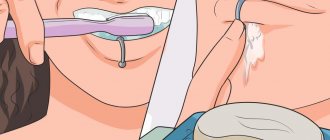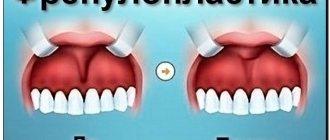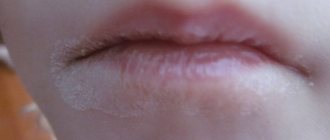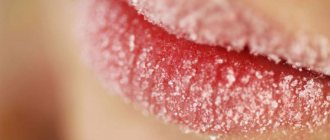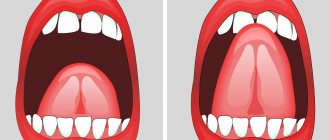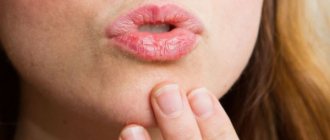Lip laceration: first aid
Pre-processing is carried out in the following sequence:
- Stop bleeding - cold is applied to the lip, followed by hemostatic agents to reduce bleeding. It is recommended to treat the wound with hydrogen peroxide to prevent inflammation.
- Reassure the person and record the time of the wound formation - if there is a large loss of blood, hemorrhagic and painful shock can occur, so talk to the victim and maintain communication with him before coming to the hospital.
- Reducing pain in the wound - the patient can be given any painkiller (Analgin, Nurofen), which will reduce pain symptoms and improve the general condition.
How to properly freeze a wound on the lip
In the absence of breathing and a threadlike pulse, it is necessary to carry out a series of resuscitation measures aimed at maintaining vital processes in the body. Artificial respiration is performed through the nose, as the wound site may become infected. Indirect cardiac massage allows you to avoid clinical death, but if performed incorrectly, complications can arise.
If the patient is unconscious, place him on his side so that if the wound bleeds, blood does not enter the stomach through the mouth. Severe painful shock can cause vomiting, so lying on your side minimizes the likelihood of vomit entering the respiratory system.
Lacerated wound of the lip: main stages of treatment
Wounds on the lips caused by a blow or other minor mechanical injury can be treated at home using special wound-healing creams and ointments. If the parting of the edges exceeds 1 cm, it will be necessary to apply sutures, which are performed by a doctor under sterile conditions.
Drug therapy
The healing time of a wound on the lip depends on the degree of its damage and the specifics of the body’s regeneration. On average, the entire process takes 2-3 weeks. To speed up healing and facilitate the entire process, the following groups of drugs are used:
Cleft lip: about scars after surgery
When performing plastic surgery of the upper lip and nose (primary or reconstructive cheilorhinoplasty), the surgeon cuts and then stitches the skin, muscles and mucous membranes. Consequently, scarring will occur throughout the incisions.
Scar formation is a natural and inevitable process that takes at least 6–8 months. During this period, the shape of the upper lip and nose may change: the upper lip is pulled up along the line of the scar, and the wing of the nose - to the nasal septum, causing a decrease in the diameter of the nasal passage, and, as a result, deformation of the nose.
Over time, the scars become less dense, paler, and the contours of the upper lip and nose take on their postoperative shape. However, not in all cases this natural process can end with the successful result expected by everyone.
A number of factors surrounding your baby, namely: sunlight, hard objects and toys, sharp corners and swings, can have an extremely negative effect on scar formation. Realizing how much the result of the operation depends on the quality of the formed scar, we strongly advise you to follow a number of our recommendations in the postoperative period.
Remember: following these recommendations will determine what your baby will be like in many years!
- Avoid sun rays: use high-protection sunscreens for children, wear panama hats and hats with a visor, walk in shady parks, avoid trips to the sea and hot regions.
- Avoid traumatizing the upper lip with any objects: fix the baby’s hands, remove hard toys, supervise the child everywhere, especially if he is already sitting or walking.
- When placing your baby on his tummy, be careful! Try to avoid lying on your stomach, especially while sleeping, for as long as possible.
- Use anti-scarring agents, such as Contractubex gel, Mederma and other gels based on liquid silicone.
- For 6 months, no matter how difficult it is for you to fight scars, use nasal inserts, this will avoid deformation of the nose and stenosis (complete disappearance) of the nasal passage.
- Consult the surgeon operating on you on all questions related to the condition of your child’s scar. You can always discuss with your doctor possible methods of treating and preventing scars: physiotherapy (electrophoresis with lidase), beech therapy and others.
- Remember: you should use procedures that hide scars (resurfacing, tattooing) only after prior consultation with the surgeon operating on your child.
Lip laceration: recommendations
The wound should be protected with a bandage, under which a tampon or bandage with ointment should be placed. Do dressings 2-3 times a day. Before applying a new layer of cream, the old one is removed by washing with hydrogen peroxide.
If the wound is infected and has become swollen and swollen, rinsing with furatsilin will help. If hardening occurs and pain increases, you will need to consult a specialist again, who will select suitable antibiotics that can stop the inflammatory process.
Chlorhexidine and miramistin can be applied to the inside of the wound, helping to prevent inflammation from spreading into the oral cavity. The use of drugs, their choice and duration of use directly depend on the degree of damage. Treatment at home is prescribed by a doctor, after which constant monitoring of the healing process is necessary.
If there are complex wounds on the face, hemorrhagic shock may require blood transfusions and the administration of solutions to replenish the volume of circulating fluid. In this case, before the procedure, a number of resuscitation measures are carried out to maintain the body in good condition.
Surgical intervention
Lip wounds with radiating edges require sutures. A local anesthetic is injected into the wound site and the edges are then sutured. The suture is treated with an antiseptic, and then a sterile bandage is applied.
Stitching a wound on the lip
The suture site is checked daily for inflammation. If the healing process is successful, the sutures are removed on the 10th day. Large complex wounds and multiple stitches may require additional assistance from a plastic surgeon.
After suturing, the patient is prescribed medications such as:
After the sutures are removed, the wound is treated with an antiseptic without a sterile dressing. To prevent the development of inflammation in the mouth, rinsing with herbal decoctions, furatsilin and treatment with hydrogen peroxide are recommended.
Stitching outside a medical facility is prohibited. Even with experience, there is a high probability of infection, since it is impossible to achieve infertility at home, which is possible in the operating room.
How is the operation performed?
During a frenuloplasty operation, depending on the type of its structure, the surgeon cuts the fold, excises excess tissue or moves the point of its attachment to the gum. The procedure is performed under local anesthesia, is absolutely painless and lasts no more than 10-15 minutes.
At the IONIKA clinic, doctors are equally proficient in both methods of frenuloplasty - laser and scalpel. Each technique has its own strict indications, its advantages and disadvantages. Despite the fact that laser plastic surgery of the upper lip frenulum has gained the greatest popularity today, we sensibly assess each clinical situation and choose the optimal way to solve the problem based on the patient’s characteristics.
- Laser . This is a minimally invasive method in which a laser beam “dissolves” the frenulum or removes excess tissue, immediately sealing the edges of the wound. The operation is completely bloodless, without the need for stitches, and rehabilitation takes a minimum of time. Laser plastic surgery of the lower lip frenulum is most often used when working with young patients.
- With a scalpel . The classical method is also low-traumatic and is supplemented only by suturing. It is used, as a rule, in cases with a thickened frenulum.
Treating a torn lip at home
Treatment of a wound on the lip, if it is small, can be done at home. The following provisions apply for this:
If redness of the wound, swelling of the skin around it and an increase in temperature appear, you should immediately consult a doctor. Such symptoms indicate the addition of an infection that provokes the development of an inflammatory process.
To reduce wound trauma, it is recommended to refrain from eating solid foods that require careful chewing and jaw movement. You can use a blender to puree your food to make it easier to swallow. It is best to eat through a smoothie straw to prevent food from getting into the wound.
Leftover food can cause tooth decay, so you should rinse your mouth after every meal and protect the wound from the inside with a disinfectant.
In the absence of comprehensive treatment, after 2-3 days the wound begins to fester and the body temperature rises. The patient's condition deteriorates sharply and requires immediate medical attention. Refusal of medical care and suturing leads to irregular and uneven fusion of the ends of the wound, which provokes the appearance of a lip. The bite is disrupted and sensitivity is reduced. As a result, the skin becomes thinner and prone to flaking and dryness.
A wound on the lip does not heal: why this happens and methods of treatment
Lip sores are very common and can appear on the upper or lower lip of a child, man or woman at any age. Such damage to the mouth area occurs for a variety of reasons, which the doctor must pay attention to when making a diagnosis and prescribing treatment.
You should not let the healing of a wound on your lips take its course, because it can fester and the pus will go into the blood. If a wound on the lip is left untreated, it will take longer to heal and an unsightly scar may form.
Causes and localization of wounds
Due to the sensitivity and thinness of the skin on the lips, which is easily susceptible to negative influences, sores of various types form. Often there are cracks, stomatitis, seizures, herpes, causing discomfort to the patient.
The emerging problem indicates the development of diseases:
- If your lips are cracked and wounds form in the corners, these are characteristic signs of jamming. The condition develops in childhood due to a lack of vitamin B2, which causes dryness. In older people, a thin film breaks due to malocclusion formed by the loss of teeth. Deep folds in the corners create favorable conditions for the formation of cracks. Patients with diabetes mellitus are at risk. Possible causes are fungal and streptococcal infections. Ulcers in the corners of the mouth cause pain when eating or talking.
- A wound on the inside of the lip is a sign of stomatitis, which affects the oral mucosa with small white sores. There is loss of appetite, fever, pain, and bleeding gums. The source can be viruses, poor oral hygiene, bad habits, parasites, lack of vitamins, dehydration, and problems with the gastrointestinal tract.
- Herpes is a rash in the form of small blisters that transform into ulcers. They cause pain and discomfort. The herpes virus resides in the human body in a dormant state and intensifies under certain conditions. People often call herpes lesions of the lips a cold, which can be localized on the oral mucosa, nasal cavity, cheeks and facial skin. When the virus is activated, a wet lump is formed, which becomes inflamed, itching and burning appear. As the wound develops, it expands in different directions, new ulcers are formed, which, when combined, form a large damaged surface.
Cracked lips occur for various reasons:
- lack of B vitamin – lactofavin;
- abuse of sweet foods;
- constant licking;
- neglect of the rules of oral hygiene;
- nervous tension, stress;
- imbalance of intestinal microflora;
- failure of the functions of the gastrointestinal tract;
- anemia;
- allergy.
In medicine, according to the international classification, the ICD-10 code for wounds on the lip is encrypted under the number K13. The condition requires timely treatment to help avoid consequences.
Why does it appear
The causes of sores on the lips can be different. The most common factor is infection with the herpes virus. The virus can lie dormant in the human body for a long time, becoming more active under the influence of certain conditions.
Symptoms of the development of the disease are ulcers or wounds on the lips; they can appear on both the outer and inner sides of the lip.
If proper and timely treatment is not provided, the virus will spread further, affecting surrounding tissues.
Other causes of wounds:
- abrasions;
- development of stomatitis;
- chronic dry skin of the lips;
- mechanical damage, resulting in a laceration of the lip, cut, bruise;
- pet or insect bites;
- acute lack of B vitamins;
- having a bad habit of licking your lips, which often results in painful cracks;
- jams;
- iron deficiency, chronic anemia;
- dysfunctions in the metabolic process;
- the wound may not heal for a long time or may fester after the piercing;
- thermal or chemical burns;
- allergic reactions to certain irritants (hygiene products, food products, cosmetics).
Damage to the upper or lower lip from the inside can occur due to trauma to the mucous membrane from a sharp tooth or a poorly placed filling. The most dangerous are lacerations.
Such injuries usually do not heal for a long time, they are difficult to stitch, and there is a high risk of complications (for example, accumulation of purulent discharge). Also dangerous are animal bites on the lip, which may be infected with rabies.
In such cases, you should immediately visit a medical facility and undergo appropriate examination and treatment.
Features of the appearance of lacerated and cut wounds
Careless actions of a housewife who decided to try cooked food from a knife or a man who made a mistake while shaving and made a cut are the causes of the problem. Lacerated and cut wounds pose a danger to human health.
Ragged injuries can be caused by a bruise, blow or bite from an animal. Such injuries to the lips are a common occurrence among athletes involved in combat sports. Characteristic signs: swelling, bleeding, pain.
Timely treatment of an open wound will help stop bleeding and prevent the penetration of pathogenic microbes. Lack of quality care will lead to complications and a long-term non-healing surface. It is recommended to visit the hospital; sometimes severe bruises and deep cuts require surgical intervention - suturing.
Lacerations in adults who were treated following all the rules disappear within one month. Healing depends on the individual characteristics of the body and the speed of metabolic processes.
Treatment of wounds on the lip
A wound on the lip should be treated when the first symptoms are detected, without ignoring medical advice or the use of medications. For therapy to be beneficial, it is recommended to adhere to the following instructions:
- maintaining oral hygiene;
- excluding fried, salty, fatty, spicy foods from the diet will reduce irritation of the oral mucosa;
- if there is itching, do not scratch or peel off the scab, the ulcer will begin to bleed and hurt;
- It is recommended to dry wet wounds with streptocide ointment, which will help avoid the inflammatory process and speed up regeneration;
- During therapy, it is recommended to provide support to the body, strengthening its protective properties through stimulants and vitamins.
Therapy is prescribed by a specialist. The main treatment is pharmaceutical drugs. Can be supplemented with folk recipes that facilitate the healing process.
You can alleviate the painful condition with medications:
